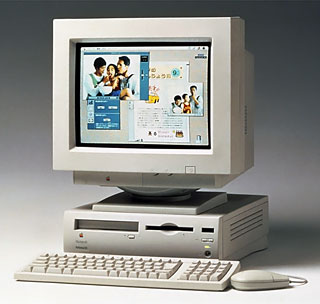It’s not often I get to write anything but groundless rumors for Luddite Mac, but the opportunity to look back at one of Apple’s finest computers ever got my interest.
 Peak Performa
Peak Performa
Anne Onymus – 2002.04.01
It’s not often I get to write anything but groundless rumors for Luddite Mac, but the opportunity to look back at one of Apple’s finest computers ever got my interest.
Like a lot of old time Mac users, I miss the modular desktop designs that Apple introduced with the Mac II (1987), shrunk with the Mac IIcx (1989), and absolutely minimized with the LC (1990). From there the desktop Macs grew to Power Mac 7500 proportions, and then ballooned to the size of the current Power Mac G4.
The LC’s drawbacks were many, as witnessed in the Road Apple report, but the size was wonderful. The best of the “flat pack” Macs was the Quadra 605 (1993) with a 25 MHz 68040 processor, room for 132 MB RAM, support for several monitor resolutions, and a single expansion slot. The only drawback: no room for a CD-ROM.
The 630 Series
 In 1994, Apple addressed that with a trio of computers: the LC 630, Quadra 630, and Performa 630. Except for the Quadra using a full 68040 CPU vs. the less costly, FPU-challenged 68LC040 in the other models, these were essentially the same computer – a Q605 with room for a CD-ROM drive.
In 1994, Apple addressed that with a trio of computers: the LC 630, Quadra 630, and Performa 630. Except for the Quadra using a full 68040 CPU vs. the less costly, FPU-challenged 68LC040 in the other models, these were essentially the same computer – a Q605 with room for a CD-ROM drive.
Perfect.
But it got better. The 630 was also the first desktop Mac to use IDE drives, which made adding storage cheap, cheap, cheap. (It still does, so a 630 with an ethernet card makes a great low-end file server.)
Not only that, but there were several new expansion slots in addition to the LC Processor Direct Slot. The Comm Slot accepted a modem or ethernet card, the video slot supported video I/O (hook it up to a TV, VCR, etc.), and the tuner slot took a TV tuner. There was even an IR port on the front for use with a remote control.
What more could you ask for?
The DOS Compatible
How about one that has two memory sockets, raising the RAM ceiling from 68 MB to 132 MB, and also has a 66 MHz 486DX2 processor on a daughter card – complete with its own RAM socket that could accept up to 32 MB of memory dedicated to the DOS side of the computer?
You could end up with 132 MB available to the Mac, which included all the AV capabilities most Mac users could have dreamt of back then, along with a 32 MB Windows (or OS/2 or Linux, etc.) machine sharing as huge a hard drive as you could afford.
Okay, the Quadra 660av and 840av may have had better AV circuitry, especially for video capture, but for an entry-level computer, either the base 630 or the DOS Compatible version offered gobs of capability. You can read a lot more about how one Mac user takes advantage of this in the Matt’s Macs columns.
All told, a decked out 630 could still be all the computer anyone needs. It can run Mac OS 8.1 comfortably, has all the legacy ports, and would work very comfortably with a 15″ display at 832 x 624 for browsing the Web, doing graphics work, etc. It’s a heck of a lot cheaper than the iMac and includes many things the iMac lacks – SCSI, a floppy drive, sound and video input, and plain old fashioned serial ports among them.
For those preferring an all-in-one design, there’s also the LC/Performa 580, which combined the 630 motherboard with a 15″ 640 x 480 display. I’d rather have the smaller computer with a separate multisync screen, but to each his own.
I don’t believe any Mac ever matched the ease of use and sophistication of the 630 with its multitude of dedicated expansion slots and DOS daughter card. If you really want the Mac experience on the cheap, you can’t beat it.
Keywords: #ludditemac #aprilfools
searchword: ludditemac


